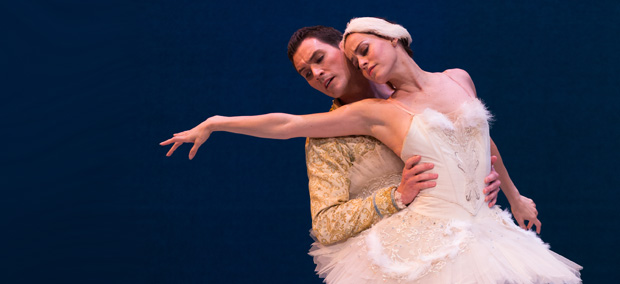
© Rosalie O’Connor. (Click image for larger version)
Suzanne Farrell Ballet
Swan Lake, Monumentum Pro Gesualdo, Movements for Piano and Orchestra, Allegro Brillante, The Concert
Washington, Kennedy Center Opera House
28, 29 November
Company Website
www.kennedy-center.org
It’s hard to imagine a better program to showcase the power of ballet as an expressive art than Suzanne Farrell Ballet’s impressive offering for its annual season at the Kennedy Center. This year’s bill included a stylistically varied selection of works by George Balanchine, a story-driven classic, Swan Lake, a starkly modernist duo, Monumentum Pro Gesualdo and Movements for Piano and Orchestra, and a pure classical delight, Allegro Brillante, all capped by Jerome Robbins’s witty comedy, The Concert.
As an added bonus, the company unveiled its new season in a grand setting, performing on the stage of the Kennedy Center’s Opera House rather than the much smaller stage of the Eisenhower Theater.

© Rosalie O’Connor. (Click image for larger version)
Balanchine created his one-act Swan Lake for New York City Ballet in 1951 as a star vehicle for Maria Tallchief. In his 30-minute-long abbreviation of the Petipa-Ivanov classic, Balanchine shone as a master of choreographic precision and economy, bringing to the fore the very essence of the all-familiar story: the impossible love between a prince and an enchanted swan maiden. In his unorthodox rendition, Balanchine discarded nearly all secondary characters. Here you will not find Jester or would-be brides or the Prince’s tutor and his overbearing Queen Mother. Most importantly, the choreographer left out the character of Odile, the Black Swan, the devious doppelganger of Odette and daughter of the evil sorcerer Von Rothbart. (It may come as a shock, but, yes, in this Swan Lake there is no Black Swan pas de deux.)
Based on the original choreography by Lev Ivanov, Balanchine’s Swan Lake was his homage to Tchaikovsky and the traditions of the Imperial Russian Ballet. While re-imagining classicism in his own way, yet maintaining the integrity of atmosphere and purpose, the choreographer created a pure dance show where emotions and dramatic motivations were expressed in movements rather than pantomime.
Farrell’s expert staging of Swan Lake brought us as close as possible to Balanchine’s original vision of this ballet. She restored the famed pas de quatre for four cygnets and brought back the original variation for the Swan Queen. The stage décor – a misty lake surrounded by a mysterious, shadowy forest – approximated the initial staging, and all the swan maidens of the corps de ballet wore white, knee-length tulle frocks. (The current New York City Ballet production, which the company brought to the Kennedy Center two years ago, is the 1986 re-staging of Balanchine’s production. This refurbished version sets the story in a wintry wonderland with an icy lake, and features a flock of swans clad in black tutus.)
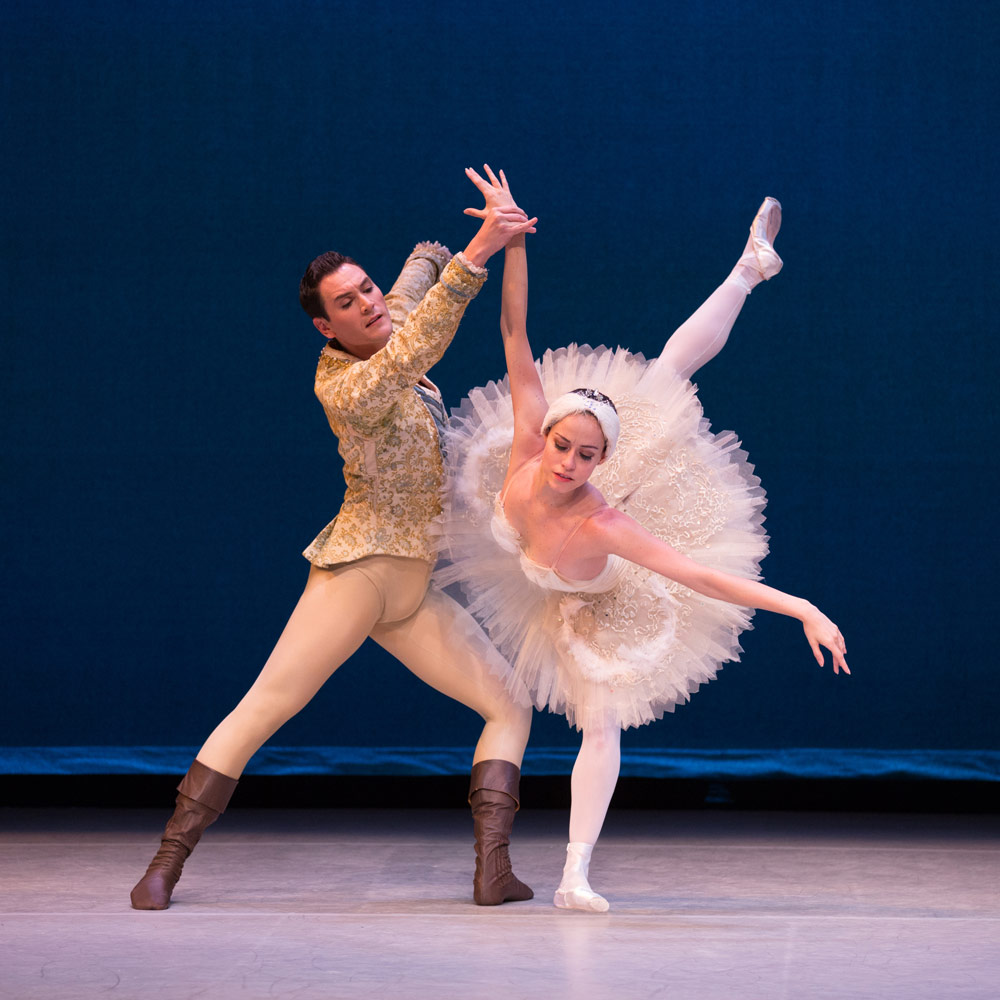
© Rosalie O’Connor. (Click image for larger version)
Natalia Magnicaballi, dancing the principal ballerina role on opening night, made her Odette a genuinely regal creature – a beautiful young woman imprisoned in the body of a swan, desperately trying to attain her freedom. Her Odette was poised yet resolute while shielding her swan-sisters from the hunters and sumptuously serene when nestling in the arms of her prince. Magnicaballi’s phrasing was clear and well-articulated, her arched arabesques and statuesque poses exquisite. In the adagio, her heroine looked both delicate and doomed, dancing with a dreamy and poignant tranquility as if accepting her tragic destiny. Michael Cook, in the role of Prince Siegfried, proved a capable partner but couldn’t match Magnicaballi’s technical and artistic level of performance.
The second cast featured Paola Hartley and Brett van Sickle in the leading roles; they both delivered a wonderfully convincing portrayal of their characters. Hartley is a petite and compact dancer: she doesn’t have the pure classical line that is usually prerequisite for a ballerina performing the Swan Queen. Yet I admired the beautiful legato of her dancing and the delicate quality of her arm movements. Her Odette was a woman transformed by love, and the emotional warmth that Hartley brought to her role is what made her performance so memorable. In the final farewell scene, as she went through a series of heart-melting embraces with the Prince, showing Odette’s vulnerability and despair, sorrow and helplessness, she restored all the drama and heartbreak to this seemingly abstract suite of pure dancing.

© Rosalie O’Connor. (Click image for larger version)
The ensemble of swan maidens was generally in good form, entering the Opera House’s grand stage in long serpentine lines and forming elaborate formations and patterns. The members of Suzanne Farrell Ballet’s corps are mostly up-and-coming young ballerinas, and for many of them, it is their first season with the company. Their technical perfection is still a work-in-progress, but their performance excited in its musicality and lyricism. There was a unique sense of dedication and purpose in their dancing and a wonderful eloquence and grace in their movements, which made their performance very special and utterly enjoyable to watch.
Audra Johnson, Bethany Lowrie, Amber Neff, and Melanie Riffee danced spiritedly in the pas de quatre. Elisabeth Holowchuk gave a crisp and clear performance as a leading swan in the pas de neuf.
The program continued to explore aspects of the art of Balanchine with two short modern ballets, Monumentum Pro Gesualdo and Movements for Piano and Orchestra, both set to music by Igor Stravinsky, Balanchine’s compatriot, friend and collaborator. Both pieces are Balanchine’s signature black-and-white ballets – concise and minimalist, with choreography full of ambiguous yet compelling logic, still fascinating, surprising and utterly modern even after all these years.
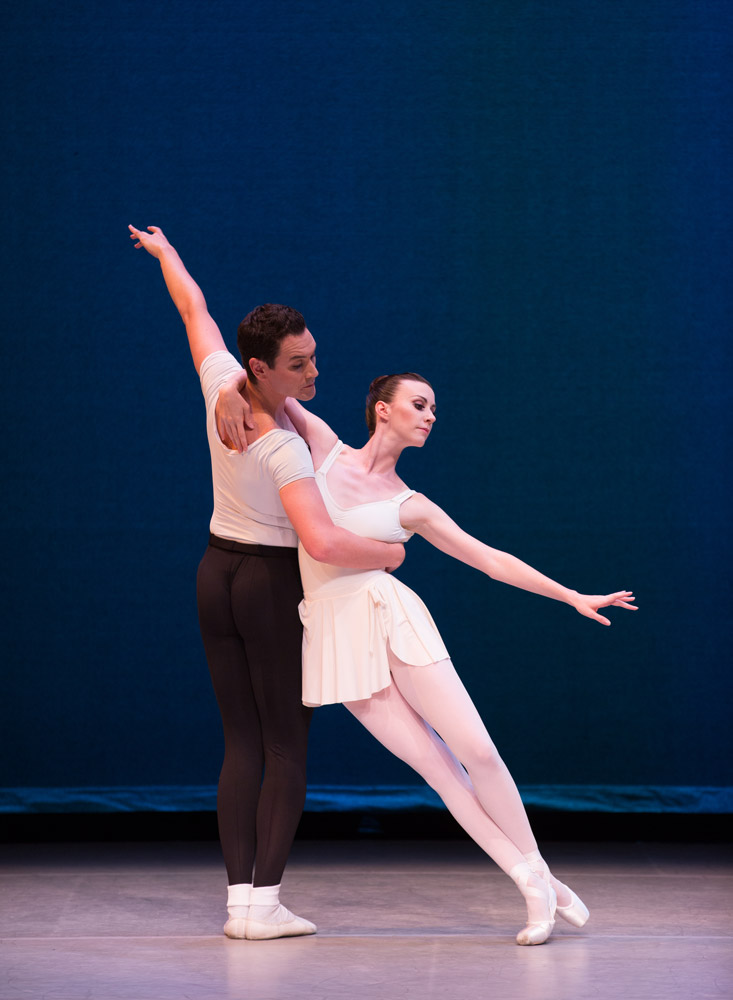
© Rosalie O’Connor. (Click image for larger version)
These ballets were envisioned as two independent works but, since 1966, they are performed in tandem. Monumentum was made in 1960 for Diana Adams. Movements three years later, also with Diana Adams in mind; yet it was the 18-year-old Suzanne Farrell who danced the leading ballerina role at the premier of Movements in April 1963. It was Farrell’s first, biggest and most important break as a member of New York City Ballet. “Before Movements, Balanchine had paid her some notice; after it, he seemed to notice nobody else,” wrote dance critic Joan Acocella in Farrell’s profile in the New Yorker.
The leading ballerina is a binding presence and driving force of these works. During the opening night performance, Holowchuk was both relaxed and spontaneous in the principal role, aptly partnered by Ian Grosh, but it was Magnicaballi, with her cool authority and air of calm and sophistication, who took charge of both pieces during the Saturday matinee performance, expertly negotiating the dissimilar patterns and moods established by the choreography and the music. Coached by Farrell for many years – Magnicaballi has been a principal dancer and a member of the Suzanne Farrell Ballet since the company’s inception – she knew this role inside out and made the part her truly own. Michael Cook was her attentive partner.

© Rosalie O’Connor. (Click image for larger version)
The second part of the program concluded with Allegro Brillante (1956), an exhilarating showpiece of classical dancing for a principal couple and four supporting couples, choreographed to Tchaikovsky’s Third Piano Concerto. Now propulsive and invigorating, now melodic and romantic, Allegro Brillante is a beautiful, unforced and exciting representation of music in movement, where Tchaikovsky’s melodies are perfectly realized in pure classical ballet.
Balancing precision with abandon, Paola Hartley excelled in the central ballerina role on opening night. Exuberance was the key to her performance, as she managed to reveal playful intricacies of the choreography while faithfully adhering to its classical formalism. A corps dancer, Audra Johnson, taking the leading role in the second cast, was vivacious and luminous but not as technically assured as Hartley. Brett van Sickle provided a secure support for both ballerinas as a leading cavalier.
A highly amusing performance of Robbins’s The Concert (staged for the company by Kipling Houston) culminated this fascinating program.
When pianist Glenn Sales walked to a grand shiny Steinway situated onstage and blew out a huge cloud of dust from the piano keys with his handkerchief, the audience burst out laughing, immediately realizing that this would be an unusual dance performance, with the pianist more than a mere accompanist.

© Rosalie O’Connor. (Click image for larger version)
On the surface, The Concert looks like a spoof on Chopin’s greatest hits and a parody of ballet itself; yet, deep down, it’s a witty and wistful reflection on human nature. This life is a concert, Robbins seems to be telling us; and we can all enjoy it if we only accept our differences and get along.
The Farrell dancers were at the top of their game in this hilarious and immensely enjoyable ballet-burlesque. Holowchuk was unforgettable as the girl in a floppy hat – an idealistic dreamer who seemed lost in a wondrous world all her own, appearing in the course of the piece in various incarnations (and various hats), one funnier than the other. Cook gave a sidesplitting portrayal of the wayward husband with murderous inclinations, complete with cigar; and Hartley nearly stole the show as the bespectacled dancer in the “Mistake Waltz.” Even more than 60 years since its premier, The Concert still retains its comic brilliance and peculiar charm.
Clearly, the company set the bar high with this ambitious and highly satisfying program. Farrell is an undisputed expert of the Balanchine tradition and style in the world today; and with each new season, her troupe allows Washington audiences to experience the art of the great master-choreographer at its most authentic.










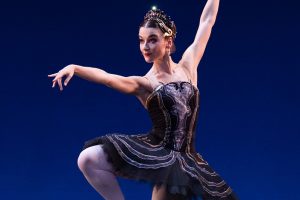

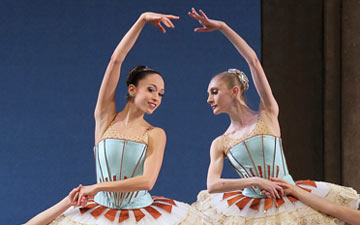
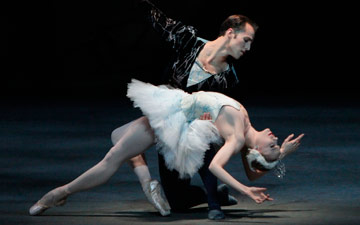
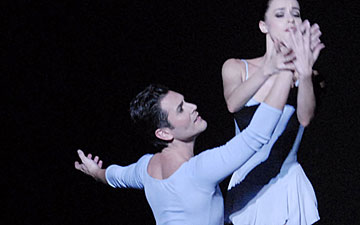

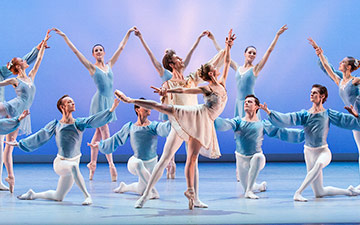
You must be logged in to post a comment.